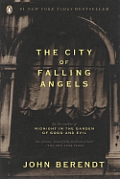
| Publisher: | Penguin |
| Copyright: | 2005 |
| Printing: | 2006 |
| ISBN: | 0-14-303693-9 |
| Format: | Trade paperback |
| Pages: | 414 |
John Berendt had made plans months before to come to Venice in early February for a couple of weeks during the tourist off-season, to explore the city when it wasn't full of sight-seers. Purely coincidentally, he arrived three days after a fire gutted La Fenice, one of the most famous opera houses in Europe. La Fenice, the fire investigation, and the complex politics and memorable characters surrounding it and a Venice restoration charity named Save Venice became the central thread that he followed through the city, and The City of Falling Angels is the result.
This is non-fiction that often reads like a novel. Berendt reconstructs and dramatizes events occasionally, putting the reader at the scene of the fire and other significant events in the stories he tells. He also tells his own story like a detective plot, following threads of personality and curiosity through Venice and the complex social structure and controversies of its upper crust. He has a knack for writing about remarkable, memorable people and finding ways to let them tell the reader what they care about and how they see their city.
Berendt also captures a remarkable sense of place. I came to this book knowing nothing about Venice, and now I not only would love to see it but I have a sense of its structure in my mind and some strong images of how parts of it may look. Berendt brings alive the canals, the tide, crumbling buildings, history layered on top of history, the damp, the complex twisty passages of the city, and the restoration projects. The view he shows is from the top: the rich, the former palaces, the well-to-do American and English expatriates, the poets and artists, and the restoration charities that appeal to royalty and the rich all over the world. He talks some of the daily life in the city but spends most of his time on the interplay of politics, socialites, and personalities. The Venice you see here is that of people whose money issues revolve around upkeep of thousand-year-old palaces. I did feel at times it was a touch skewed, but the portrait he paints is mesmerizing.
The City of Falling Angels takes its name from a sign posted in the 1970s outside a crumbling Venice church decorated with crumbling marble statues: "Beware of falling angels". It's a metaphor for the story and for Berendt's view of Venice, one steeped in history and inertia, crumbling and in constant need of restoration, covered in historical treasures everywhere one looks, and obsessed in ways good and bad with the past. The Fenice fire, the initial impetus of the story, starts as both a loss of history and a reconstruction project (talk of rebuilding started immediately after the fire), but then sinks into the murk of Venice politics, an arson investigation, and the difficulty of building or rebuilding anything. By the time the fire investigation is brought to a conclusion, Berendt has shown so many competing notions of history, so many complex feuds and suspicions, and so much inertia and back-channel communication that one doubts any event in Venice has a clear beginning and a clean resolution. The most memorable part of Berendt's portrayal for me is the weight of history and entanglement, the combination of crumbling fragility, historical significance, and powerful inertia carried by not just the architecture and decoration but by the people, the politics, the relationships, the neighborhoods, and the flows of money and society.
I found it fascinating the degree to which Berendt shows Venice as influenced and even overwhelmed by those who are not natives. At the start, it's the tourists, who descend on the city bringing both money and problems. The tourists feed the pigeons and in some ways are the pigeons: huge amounts of money are made selling pigeon food, so the feeding of the pigeons cannot stop, but the pigeons are a plague on the regular inhabitants. Many would love to see them killed, or at least their numbers thinned, but then there are animal rights defenders who would be upset and money that would be lost. So a balance is found, with much of the balance being off any official record.
After the tourists, there are the restoration charities, again not native and again bringing money into the city, in part through highly expensive parties in and rentals of Venice's famous buildings. The charities bring their own politics and have to dance a careful dance with the locals, maintaining a close enough connection to work through Venice bureaucracy and to maintain access to the buildings and venues that draw rich doners.
Not all of this book is as compelling as the original description of the fire and its aftermath, and by the end of the book I was a touch tired of the interminable feuds over power and privilege between people in exhaulted social strata. But I think Berendt succeeds marvelously in conveying the complex and ambiguous attitude towards history and its preservation, the way those who want to preserve and control history are sometimes predatory on those who live inside it, and the need to step lightly and adroitly around the history that suffuses an old city. And, at a more basic level, Berendt paints a beautiful and evocative picture. This was good enough that I now want to read Midnight in the Garden of Good and Evil.
Reviewed: 2007-02-12